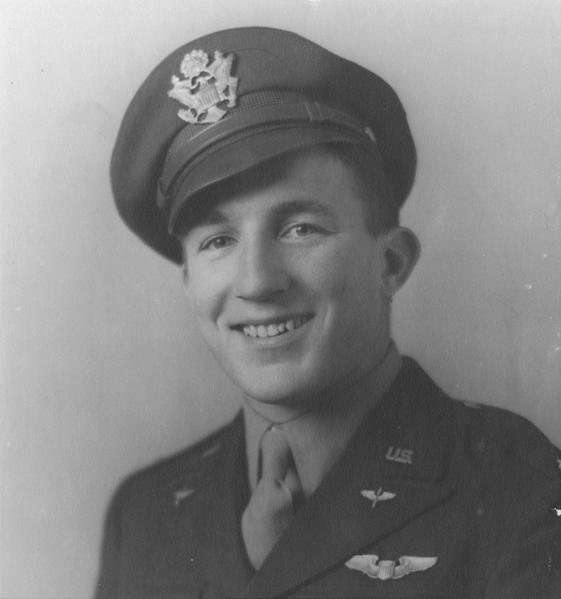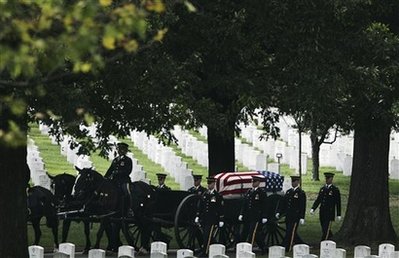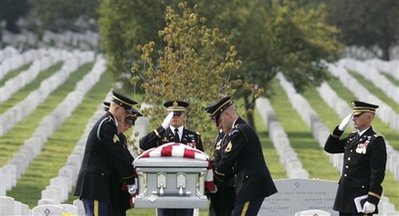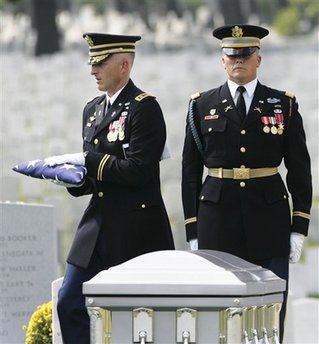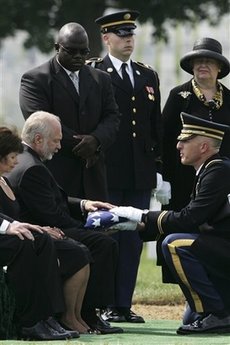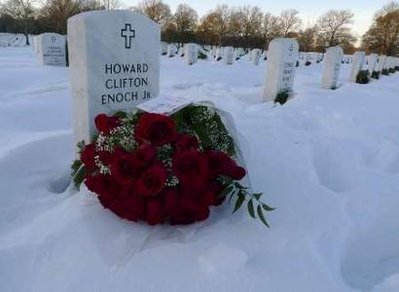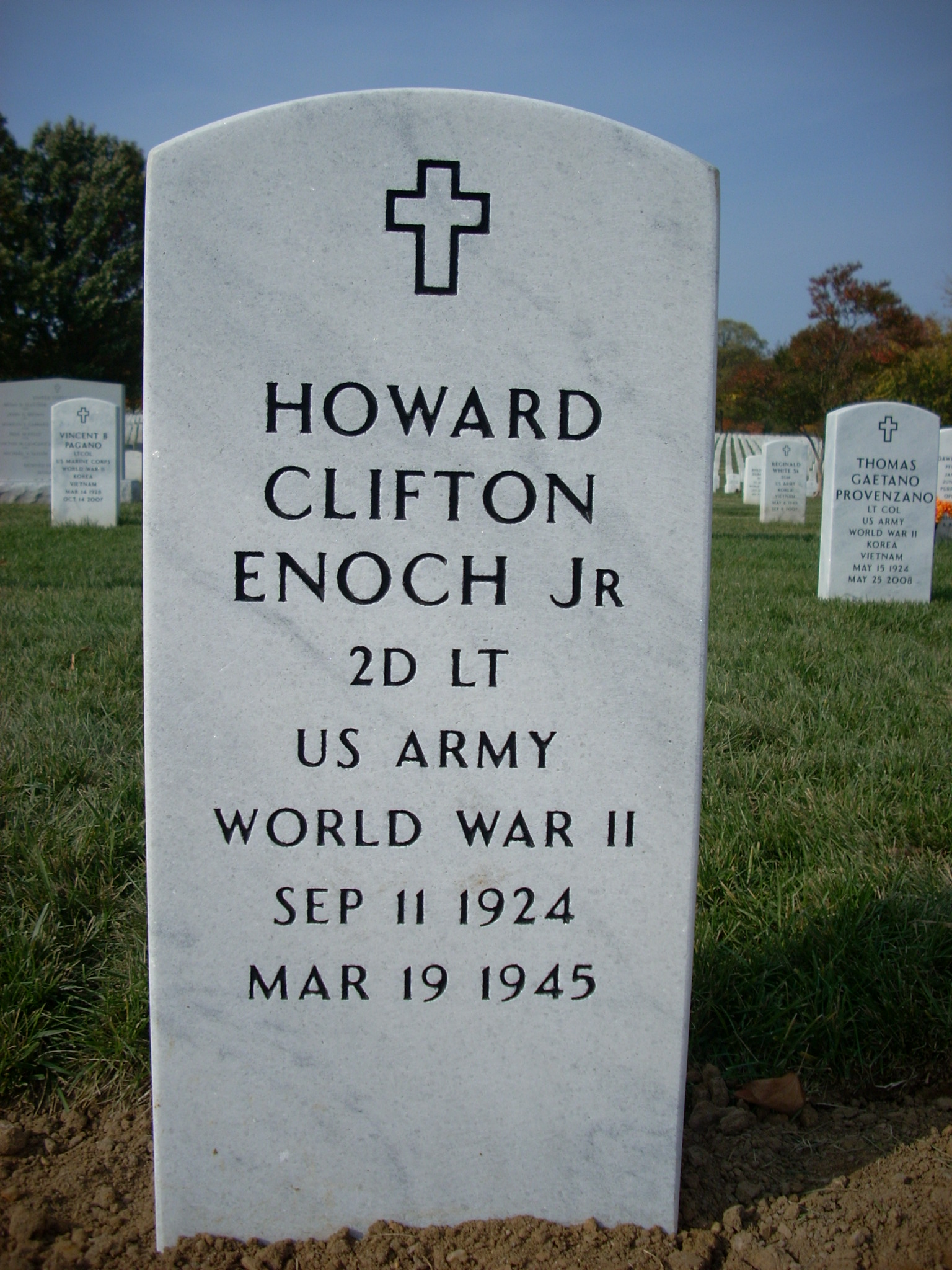Clifton Enoch, Jr.
- Second Lieutenant, U.S. Army Air Forces
- Service # O-829832
- 368th Fighter Squadron, 359th Fighter Group
- Entered the Service from: Kentucky
- Died: 19-Mar-45
- Missing in Action or Buried at Sea
- Tablets of the Missing at Henri-Chapelle American Cemetery
Henri-Chapelle, Belgium - Awards: Air Medal, Purple Heart
63 years after death, soldier is going home
By James Vaznis
Courtesy of the Boston Globe
2 July 2008
His P51D fighter plane under attack by the Luftwaffe, 20-year-old Howard Enoch Jr. ultimately plunged to the ground in Germany, never to be heard from again.
That was March 19, 1945, and the crash site would become part of East Germany, behind the Iron Curtain, making it all but impossible for the US government to recover remains of fallen soldiers.
But reunification of Germany more than a decade ago helped the United States strike an agreement with the government to let the US military search the former East Germany area for remains. That enabled the military to locate and ultimately identify Enoch’s remains and pieces of the wrecked plane.
Now, Enoch’s son is planning the burial of a father he never knew.
In a face-to-face meeting in April, two US Department of Defense officials told him of the positive identifications of the remains, at a gathering of family members of missing soldiers in Connecticut.
“I totally fell apart,” said Howard Enoch III, 63, director of the Robsham Theater Arts Center at Boston College. “It was the bitter sweetness of a dream come true and sadness of the lost years.”
The son was born three months after his father’s death.
The older Enoch entered the Army on April 15, 1944. He was a second lieutenant when he flew solo over Germany and was engaged with enemy aircraft 20 miles east of Leipzig when he went down, according to the Defense Department.
Eight years later, the military declared the soldier unrecoverable. “I never held out hope of knowing what happened to my father,” Enoch said in a recent telephone interview.
Four years ago, as part of a review of crash sites in the former East Germany, Defense Department officials found small fragments of the plane scattered over an area the size of a football field.
Two years later, military investigators returned for an excavation, recovering human remains and aircraft wreckage. A year later, the remains were sent to a lab for identification. A forensic analysis confirmed the identity in April.
The younger Enoch said that the Army will visit him in Framingham this month to make arrangements for a burial.
“For so many years, he was resting quietly in that field,” Howard Enoch said.
“I think my dad deserves all the recognition and honor I can get for him,” he said. “He truly is a hero.”
Army finds remain of local man’s father
By By Dan McDonald, Framingham, Massachusetts, Daily News
5 July 2008
Howard Enoch III keeps a memorial to his father on a shelf in his living room, where black-and-white photos are joined by military distinctions that include a Purple Heart, air medal and a pilot ring he used to wear, but stopped for fear of scratching it.
“It’s ironic that someone’s life is reduced to possessions that can fit into a couple cardboard boxes,” said Enoch.
His father’s name is also featured on the Tablets of the Missing at the Henri-Chappelle American Cemetery in Belgium.
Enoch never knew his father because Second Lieutenant Howard “Cliff” Enoch Jr. boarded a P-51D Mustang fighter on March 19, 1945, in East Wretham, England, bound for a mission over Halle, Germany, never to return. A firefight just east of Leipzig, Germany, ultimately caused him to go into a fatal nosedive.
Only 19, he left behind a 17-year-old wife and an unborn son in the hills of western Kentucky.
That son, Howard Enoch III, is now 63 years old and lives on Hilltop Lane in Framingham, Massachusetts.
On April 19, 2008, Enoch learned he would have something more than engravings and tokens of military merit to remember his father by.
It was on that date the Army told him his father’s remains had been identified.
Enoch had long accepted that the unknown would cloud his father’s disappearance over eastern Germany.
When he reached the age to comprehend his father’s disappearance, his mother had remarried. The subject of his father was not often broached.
“My mother never talked about my father,” said Enoch, who has lived in town for the past 13 years and serves as a director for a theater arts center at Boston College.
One of the few people who can recall Enoch is distant cousin and Kentucky native R.C. Hamilton.
“He was a nice young man, a good student from what I remember,” said Hamilton, 82, from his Kentucky home. “I recall we used to play together a whole lot. During the Depression, there was not much else to do but visit friends and kinfolk. I recall he had a few toys I didn’t have. I think it’s great they found him.”
Inside his home nestled in a wooded northwest nook of Framingham near the borders of Sudbury and Marlborough, Enoch tried to articulate the closure.
“It’s hard to describe the bittersweetness,” said Enoch, his eyes watering. “I wished he had been around, and I never expected to know anything about him. It’s amazingly powerful.”
As it turns out, his father’s plane crashed in what would later become Soviet-controlled East Germany, hampering recovery efforts during the Cold War.
Compounding matters, World War II debris was so commonplace in Germany that a crashed plane was unlikely to cause much of a stir.
“You can’t dig a hole in Germany without hitting munitions or pieces of airplanes or something that blew up,” said Enoch. “So there’s just so much there to the local people it’s no big deal.”
The pilots who were flying with Enoch misidentified the location of the crash site, further complicating the search.
“This is no one’s fault. There was no GPS. They were going by landmarks in a country they had never been in before,” said Enoch.
In 2004, German historian Hans Guenther Ploes identified a particular rural area as a potential location of plane wreckage.
In 2006, U.S. government dig teams sifted through the wreckage and found what at the time were termed “possible human remains.”
“It was the Army, they were being cautious,” said Enoch.
The archaeological findings were then sent to a lab in Hawaii for analysis.
The Army studied the geography of the crash, the style and plane identification, and, ultimately, DNA.
“They were trying to eliminate all the other possibilities just to make sure this was my dad’s crash site,” said Enoch.
Now, Enoch hopes for a military burial at Arlington National Cemetery in Virginia by the end of August.
Six decades after he was lost in action over Nazi Germany, Kentuckian Howard “Cliff” Enoch Jr. was buried with full honors across the river from the nation’s capital.
Enoch, a Second Lieutenant in the U.S. Army Air Forces, was interred this afternoon at Arlington National Cemetery as the son born three months after his death, Howard Enoch III, now 63, looked on.
Lieuenant Enoch was from Marion, Kentucky. He was 20 when the fighter plane he was piloting, a P-51D Mustang, was shot down on March 19, 1945, near Doberschutz, Germany, close to the end of World War II.
His remains were not recovered until 2006 and were identified last year.
Chaplain Major David Baum led the gravesite service, which included a fly-over by two T-6 Texan II aircraft and a traditional 21-gun salute.
In a prayer, Baum asked God to “cause us always to remember that what we have was bought at a terrible price.”
23 September 2008:
As the soldiers in their dress blues marched off, Howard Enoch III stood Monday at his father’s graveside, clutching the folded American flag that had covered the casket.
For six decades, Enoch’s father, Second Lieutenant Howard “Cliff” Enoch Jr. of Marion, Kentucky, had been one of the missing of World War II, lost in action over Nazi Germany.
Now, Lieutenant Enoch finally was at rest on American soil.
He was interred Monday at Arlington National Cemetery, across the Potomac River from the nation’s capital, as his 63-year-old son, born three months after his death, looked on.
“For me, it is a dream come true, because now I have a place where I know my father is,” Enoch said after the service. “It’s a gift to know that you know where someone is, and they’re resting in peace.”
Lieutenant Enoch, of the U.S. Army Air Forces, was 20 when his fighter, a P-51D Mustang, was shot down March 19, 1945, during a battle with enemy planes east of Leipzig. The fighter plane crashed near the village of Doberschutz, Germany.
The Soviet Union occupied eastern Germany after the war. The crash site was not found until 2004, and the remains were not recovered for another two years.
Last year, scientists from the Joint POW/MIA Accounting Command and the Armed Forces DNA Identification Laboratory identified the remains as those of Lieutenant Enoch.
Monday at Arlington, full honors for the fallen flier included a horse-drawn caisson, a full Army band unit, an escort platoon, a flyover by two T-6 Texan II aircraft, a traditional 21-gun salute by a seven-man firing party and a lone bugler playing taps.
Army Chaplain Major David Baum led the graveside service. In a prayer, Baum asked God to “cause us always to remember that what we have was bought at a terrible price.”
Later, kneeling, Baum presented the flag on Lieutenant Enoch’s casket to his son, then stood and saluted.
With Enoch were his wife, Lynda, and their two daughters, 9-year-old Emily and 6-year-old Abigail. They live in Framingham, Massachusetts, where Enoch directs the E. Paul Robsham Jr. Theater Arts Center at Boston College.
Also at the service were Howard Enoch III’s half sisters, Jane Marie Fuller and Patricia Louise Larson, both of Hopkinsville, Kentucky.
The family – who met with Senate Minority Leader Mitch McConnell after the service – was accompanied by friends from Kentucky and members of the 359th Fighter Squadron, Lieutenant Enoch’s squadron.
“I thought the ceremony was absolutely magnificent – everything about it was absolutely the best,” Enoch said. “I think my dad was really very, very much honored.”
After not knowing for so long what happened to his father, Enoch praised the efforts of strangers who have made it their lives’ work to find the missing and return them.
“Before this, I always thought of my father as a young man, sitting in a beautiful pasture in Germany, waiting for someone to bring him home – and that is what happened,” Enoch said.
A horse-drawn caisson carries the remains of World War II veteran Army 2Second Lieutenant Howard C. Enoch, Jr.,
Monday, September 22, 2008, during funeral services at Arlington National Cemetery
An Army honor guard prepares to lower the remains of World War II veteran Army Second Lieutenant Howard C. Enoch, Jr.,
of Marion, Kentucky, Monday, September 22, 2008, during funeral services at Arlington National Cemetery
Army Chaplain, Major, David Baum, left, speaks during the graveside service of World War II veteran
Army Second Lieutenant Howard C. Enoch, Jr., Monday, September 22, 2008, at Arlington National Cemetery
Army Chaplain, Major, David Baum, left, prepares to present an American flag to the family of World War II veteran
Army Second Lieutenant Howard C. Enoch, Jr., Monday, September 22, 2008, during funeral services at Arlington National Cemetery
Army Chaplain, Major, David Baum kneels as he presents an American flag to Howard C. Enoch III, the son of World War II veteran Army
Second Lieutenant Howard C. Enoch Jr., Monday, September 22, 2008, during funeral services at Arlington National Cemetery
Snow covers the gravestone of Howard Clifton Enoch Jr. in Section 60 of Arlington National Cemetery
during sunset two days before Christmas day in December 23, 2009
ENOCH, HOWARD CLIFTON JR
- 2DLT US ARMY
- WORLD WAR II
- DATE OF BIRTH: 09/11/1924
- DATE OF DEATH: 03/19/1945
- BURIED AT: SECTION 60 SITE 8483
ARLINGTON NATIONAL CEMETERY
Michael Robert Patterson was born in Arlington and is the son of a former officer of the US Army. So it was no wonder that sooner or later his interests drew him to American history and especially to American military history. Many of his articles can be found on renowned portals like the New York Times, Washingtonpost or Wikipedia.
Reviewed by: Michael Howard

